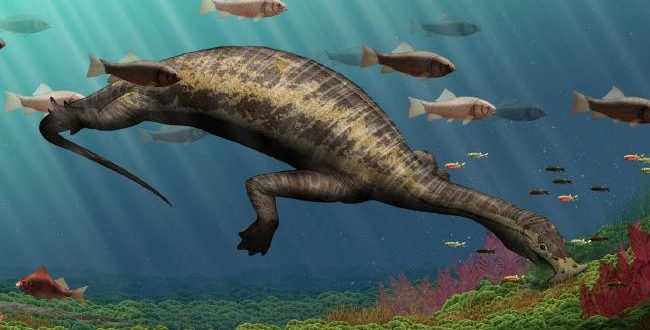A bizarre, prehistoric sea-dwelling reptile with a weird hammerhead mouth has been identified by archaeologists as the first herbivorous or plant eating marine reptile.
Researchers have discovered the fossil remains of a bizarre crocodile size reptile in Southern China back in 2014. The creature was a sea-dweller and lived 242 million years ago long before the time when dinosaurs roamed on the Earth.
“It’s a very strange animal,” says Olivier Rieppel, Rowe Family Curator of Evolutionary Biology at The Field Museum in Chicago. “It’s got a hammerhead, which is unique, it’s the first time we’ve seen a reptile like this.” Rieppel co-authored the study with colleagues at National Museums Scotland and China’s Institute of Vertebrate Paleontology and Paleoanthropology and the Wuhan Centre of the China Geological Survey.
The reptile’s name, Atopodentatus unicus, hints at its muddled past–it’s Latin for “unique strangely toothed.” But newly discovered fossils make it clearer how its “strange teeth” were actually configured. Its wide jaw was shaped like a hammerhead, and along the edge, it had peg-like teeth. Then, further into its mouth, it had bunches of needle-like teeth.
“To figure out how the jaw fit together and how the animal actually fed, we bought some children’s clay, kind of like Play-Doh, and rebuilt it with toothpicks to represent the teeth,” says Rieppel. “We looked at how the upper and lower jaw locked together, and that’s how we proceeded and described it.”
The verdict: Atopodentatus unicus used its bizarre jaw to help it eat plants. “It used the peg-like front teeth to scrape plants off of rocks on the sea floor, and then it opened its mouth and sucked in the bits of plant material. Then, it used its needle-like teeth as a sieve, trapping the plants and letting the water back out, like how whales filter-feed with their baleen,” explains Rieppel.
Not only does this discovery solve the mystery of the strange-toothed animal, but it also provides us with an example of the first herbivorous marine reptile. “The jaw structure is clearly that of an herbivore,” says Rieppel. “It has similarities to other marine animals that ate plants with a filter-feeding system, but Atopodentatus is older than them by about eight million years.”
Atopodentatus also helps tell a bigger story about the world’s largest mass extinction 252 million years ago. “Animals living the years surrounding the Permian-Triassic extinction help us see how life on earth reacted to that event,” says Rieppel. “The existence of specialized animals like Atopodentatus unicus shows us that life recovered and diversified more quickly than previously though. And it’s definitely a reptile that no one would have thought to exist–look at it, it’s crazy!”
Agencies/Canadajournal

 Canada Journal – News of the World Articles and videos to bring you the biggest Canadian news stories from across the country every day
Canada Journal – News of the World Articles and videos to bring you the biggest Canadian news stories from across the country every day

